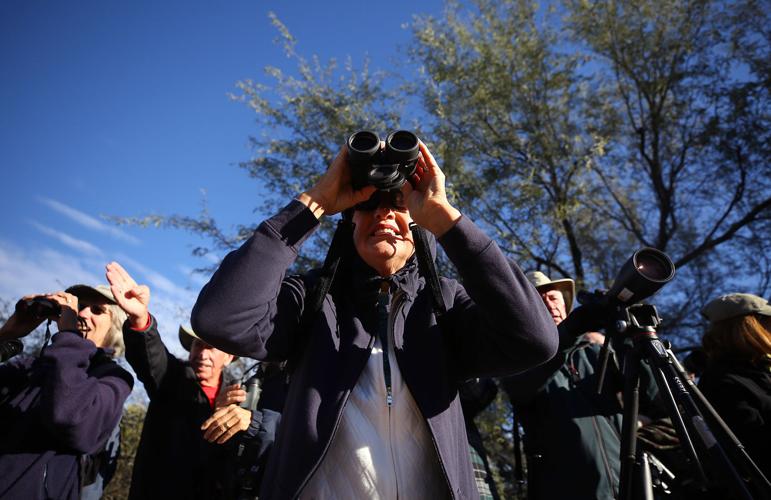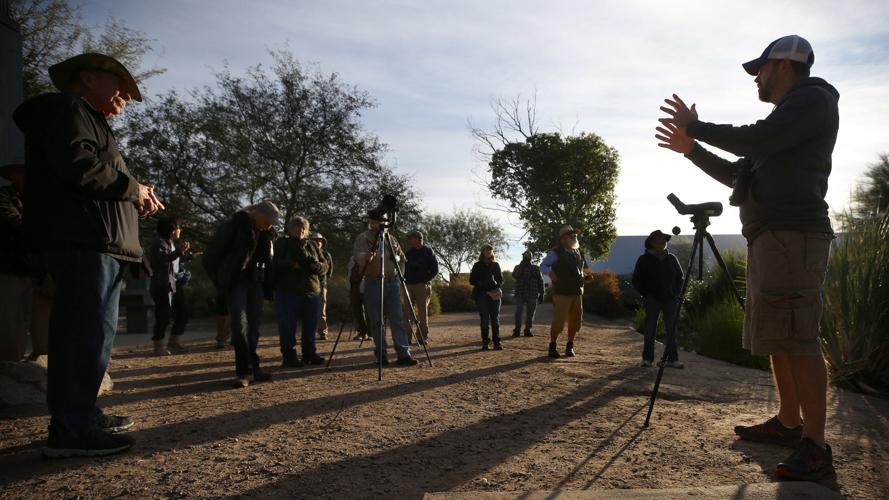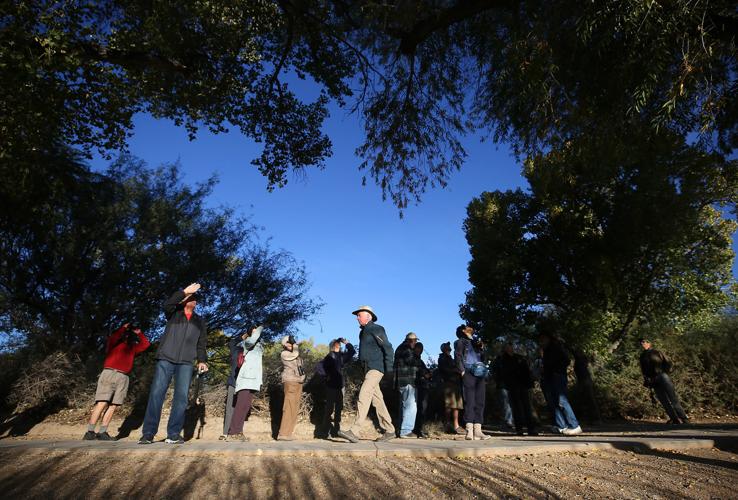
Tour leader Luke Safford, right, addresses a group before heading out for a guided tour by the Tucson Audubon Society through Sweetwater Wetlands. Safford says Tucson “is one of the best places to bird-watch.”
Bring along your binoculars and your birding book for a scenic tour through Tucson’s Sweetwater Wetlands.
The colder months are the busiest for the free Sweetwater tour with winter visitors coming to Tucson for the nice weather and bird-watching.
Kim and Kerry Martin, an expert bird-watching couple, spend their winters here and the rest of the year in Alaska.
“We came here on vacation to bird-watch and fell in love with it,” Kerry Martin said.

Kim Martin, left, and Anne Mook consult a birding book during their tour of Sweetwater Wetlands. Handy for identification purposes, birding books are a must for bird-watchers.
The couple stays in Oro Valley and attends bird-watching tours frequently during their time in Arizona.
Led by Luke Safford, an Audubon Society volunteer and expert birder, the walking tour every Wednesday gives birders of all levels the opportunity to spot waterfowl, warblers and other interesting species in the hundreds.
Steve Buck, an Audubon Society member and recent retiree, has enjoyed bird-watching in Tucson for 25 years.
“I retired three years ago to be able to bird-watch in Tucson full time. Most people don’t know this, but Tucson is one of the best places to bird-watch. Many people, including myself, have spotted some pretty rare ones here.”
Buck always has his birding book handy which is hefty and informative. He arguably has the best eye in the group, pointing out a rare black-and-white warbler, concealed amongst the branches of a tree. Safford and the rest of the birders rush to the base of the tree to get a good look at the extraordinary creature with their state-of-the-art binoculars.

Laura Broyles, center, uses her binoculars to look at a bird during a weekly guided tour through Sweetwater Wetlands. Most of the bird-watchers use state-of-the-art binoculars.
These birders do not mess around when it comes to bird-watching technology. Most have top of the line, one-lens binoculars that sit on tripods to get a high-definition view of birds. To achieve professional birder status, the regulars say that one of these is essential to have in your kit.
The tour travels through marshes, reeds, valleys and lakes — where various species of duck float along.
The most popular spot to gaze at waterfowl is at the gazebo which overlooks a stunning body of water. Flocks of game clean their feathers and bask in the 8 a.m. sun which is low in the sky.
Safford points out a female ring-necked duck dunking her head below the water. Through binoculars, every droplet of water beading on her black feathers is visible. The birders spend the most time here, admiring each bird that glides by.

The group peers into a tree to try and spot a rare black-and-white warbler during the Sweetwater Wetlands tour. The tour is free and lasts about two hours.
The tour lasts about two hours, as birders take their time examining and comparing birds with one another.
At the end of the tour, Safford requests everyone’s email to send a full list of each bird spotted that day. In case you are not yet a birding expert, Safford provides a link to view a picture and a short description of each bird that you may have missed.
Don’t miss out on the rich birding culture that Tucson and the Audubon Society have to offer and take a Sweetwater tour. Who knows, you might fall in love with birding.





